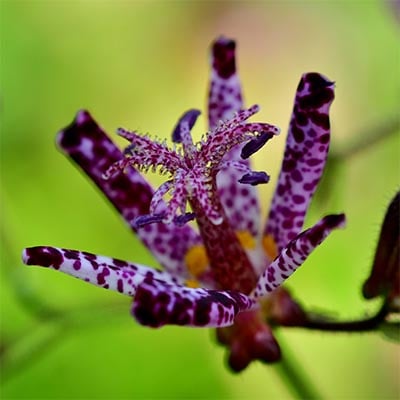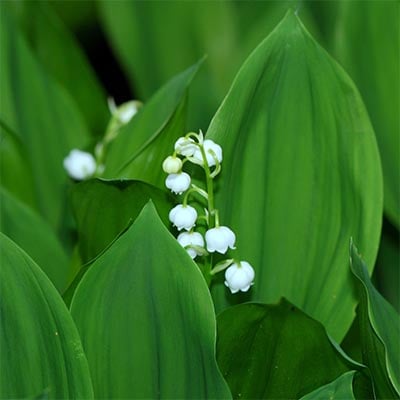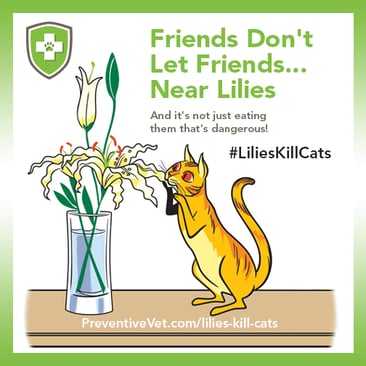
Lilies Kill Cats
The "true lilies" and daylilies are extremely toxic to cats, given their devastating effect on a cat's kidneys and how common they are in bouquets and as stand-alone flowers and plants.
It is critical to quickly catch any exposure to any lily that may be toxic (toxic list below).
It takes only a nibble on one leaf (even dead ones) or stem, the ingestion of a small amount of lily pollen (easy to do when a cat grooms itself), or a lap of water from a vase holding cut lilies to send a cat into acute kidney failure and you rushing to the emergency vet. While lilies are most dangerous to cats, some varieties are very harmful to dogs; see the lily list below.
If you believe that there is ANY chance your cat or dog was exposed to or ingested any part of a lily (remember all parts of the plant are toxic), contact a veterinarian, animal emergency hospital, Animal Poison Control Center (888-426-4435), or Pet Poison Helpline (855-764-7661) IMMEDIATELY.
This is a medical emergency, and it is critical that your cat receives prompt veterinary treatment. Within 12 to 36 hours of lily intoxication, untreated cases result in acute kidney failure, and death occurs within 3 to 5 days after exposure.
To help your veterinarian determine if the lily is one of the highly toxic ones, bring the plant or a photo of it with you. This will help quicken the diagnosis and the treatment plan.
Be sure to inform the veterinarian if your cat is showing any symptoms of lily toxicity.
Initial Clinical Symptoms Soon After Lily Exposure
- Nausea
- Excessive drooling
- Vomiting
- Lethargy
- Decreased activity
- Loss of appetite
Symptoms 12 to 24 Hours After Lily Exposure
- Increased thirst
- Increased urination
- Dehydration
NOTE: These latter symptoms are signs of kidney damage. As the condition progresses, the kidneys may fail to produce urine. Although, when kidney damage begins, there is increased urine production. The condition is life-threatening at this point, and death can occur within 36 to 72 hours without proper veterinary treatment.
Why Do Lilies Kill Cats?
Allergies are not the reason that cats are more severely affected by lily toxicity than dogs or other animals. Unfortunately, the toxin of lilies that only affects cats has yet to be identified. It isn’t clear if it is the toxin itself or a specific metabolite that is created following consumption by cats.
As with any toxin, it appears some cats are more susceptible than others to the effects of lily toxicity. The degree of kidney failure varies from cat to cat. Some cats are fortunate enough only to need minimal therapy, whereas other cats require extensive treatment such as dialysis. But there is no way to know beforehand how severely a cat may be affected.
If your cat ate a lily or any part of it and nothing happened, consider yourself and your cat extremely fortunate – though they may not be if it were to happen again! This is not a "wait and see" situation. Time is of the essence to get your cat looked at by a veterinarian, as it could become a deadly situation.
Which Lilies Are Poisonous for Cats?
'True' Lilies (lilies that affect the kidneys)
Avoid any of the following lilies (Lilium spp., Hemerocallis spp., or Convallaria spp.) if you have pets (see how lilies affect dogs below).
All parts of these plants are toxic. Consumption of water that contains lilies or their pollen, even a few grains, can cause problems.
Significant trauma to the kidneys can occur even if your cat only consumes a small amount of ANY part of the plant or flower, even dried-up parts.
Easter Lily (aka Asiatic Lily) (Lilium)

Japanese Lily (Lilium)


Oriental Lily Hybrids (Lilium)


Rubrum Lily (Lilium)

Stargazer Lily Rubrum Lily (Lilium)

Casa Blanca Lily (Lilium)

Tiger Lily (Lilium)


Wood Lily (Lilium)


Daylilies (Hemerocallis)


If too much time passes before you notice your cat has ingested a part of any of these lilies and appropriate treatment is started, the outlook worsens, and death from the disease or the need to euthanize is more likely. The sad truth is that acute (sudden) kidney failure will be fatal without treatment.
Chronic kidney disease – which is not caused by lilies – is a manageable disease with appropriate treatment.
Other Toxic ‘Lilies’
There are some plants that have the common name ‘lily’ but are not ‘true’ lilies. Though none of these are ‘true’ lilies and are in completely different genera than the true lilies and daylilies discussed above, they can cause problems for cats in entirely different ways. The following lilies fall under this category:
Lily of the Valley (Convallaria spp.)

Like the foxglove plant, the lily of the valley contains cardiac glycoside compounds that can cause the heart to beat abnormally (called an arrhythmia) and can lead to cardiac arrest for cats (and people!).
Cats often experience stomach upset (vomiting and diarrhea) as well.
Gloriosa Lily (aka Climbing Lily, Flame Lily, Glory Lily, Glory Flower, Flame-of-the Woods)

This type of lily is not a member of the lily family that causes kidney failure in cats. But its toxic component, colchicine, can be just as dangerous, especially since death can be the end result.
All parts of the plant are toxic. However, the seeds and tubers contain the highest concentration of colchicine. Even dried, the plant is toxic. If a cat chews on them, they may consume enough toxin to cause significant multi-system organ failure. Symptoms, which can develop in phases or waves, include salivation, vomiting (bloody), diarrhea (bloody), shock, seizures, kidney failure, liver failure, disseminated intravascular coagulation (DIC – abnormal blood clotting throughout the body’s blood vessels), and bone marrow suppression.
Calla Lily (aka Trumpet Lily) (Zantedeschia spp.) and Peace Lily (Spathiphyllum spp.)


Both calla lilies and peace lilies contain insoluble oxalates that can cause irritation and inflammation of the tongue and other tissues within the mouth and the tissues of the digestive system when swallowed.
Very rarely, these insoluble oxalates can cause inflammation and swelling around the entrance to the trachea ("windpipe") and make it difficult for an affected cat or dog to breathe.
Peruvian Lily

The Peruvian lily is the least toxic of all lilies as the toxin only causes mild gastrointestinal upset (vomiting and diarrhea) when consumed in large amounts.
Treatment for Renal Toxicity from Lilies
Acute kidney (renal) failure is always debilitating to your pet and expensive for you. The outlook for cats with acute kidney failure resulting from eating lilies can be good so long as early and aggressive treatment is pursued.
Veterinary treatment for lily-induced acute kidney failure involves inducing your cat to vomit (if the plant was ingested less than 2 to 3 hours prior to arrival), providing activated charcoal, aggressive IV fluids, injectable medications, nutritional support, and very close monitoring.
An essential part of monitoring will include repeated blood work and urinalysis to monitor how your cat’s kidneys are doing.
Depending on the severity of your cat’s condition, you can expect them to be hospitalized anywhere from 2 days up to 10 days (possibly longer if dialysis is needed).
If this initial treatment is unsuccessful, advanced options, such as peritoneal dialysis, continuous renal replacement therapy, or renal dialysis, are considered.
These treatments are not cheap and are also not available at all veterinary clinics.
In fact, because treatment for acute kidney failure resulting from lily toxicity is so intense, it is best to have your cat treated at a specialty veterinary emergency hospital right from the get-go.
Hospitalization and treatment costs for this condition will depend on the severity of the case and your cat’s response to therapy. It can safely be assumed that a hospital bill will likely start at $2,000 and could increase to $4,000 or more.
This condition cannot be conservatively treated – delay in starting the appropriate treatment worsens the cat’s survival rate and increases treatment costs.
With early intervention, there is hope! This study demonstrates that 25 out of 25 cats did well after prompt veterinary care.

How to Keep Cats and Dogs Safe from Lily Toxicity
Preventing a cat’s exposure to lilies is of the utmost importance, and there are several easy ways to help prevent this toxicity.
- If you live with cats, never have lilies in your home. Regardless of how out of reach you think they may be, it’s just not worth the risk. Cats jump, dead leaves fall, vases spill and pollen travels on breezes – any of these scenarios can kill your cat. For dogs, make sure to keep any type of lily or toxic plant out of reach.
- Keep your cats indoors. Many people have lilies in their gardens. If your cat is outdoors, unless they are in a secure outdoor enclosure (such as a catio), there is no way to ensure that they will not eat or rub up against those lilies.
- If you walk your cat on a leash outdoors, avoid contact with lilies in other people's yards or parks. The same goes for dogs, and make sure your flower beds and gardens don't contain any toxic lilies or plants. Remember, it only takes the consumption of a few grains of pollen to cause toxicity, which can happen easily sniffing in a flower bed.
- When sending flower bouquets to friends or family members with cats, specifically request no lilies. To make sure they listen to your request, tell them that the recipient is deathly allergic to the flowers. Some florists may not be aware of the dangers of lilies to cats, and they don’t need to know that the ‘recipient’ you are referring to is your friend’s cat.
- Avoid using any type of lily in a wedding bouquet or boutonniere, as these are often kept as keepsakes, and even in their dried form, they can be fatally poisonous.
- Inform your friends and family members of the dangers of lilies to cats. The more people that know about the risk, the more cats we can save from lily toxicity and possible death.
Do Lilies Kill Dogs?
Thankfully for dog lovers, the effect that the toxin in ‘true’ lilies has on cat kidneys isn't seen in dog kidneys. However, both true lilies and other lilies are still considered poisonous to dogs.
True lilies typically only cause gastrointestinal upset in dogs.
The lily of the valley and Gloriosa Lily (flame lilies) should be considered very toxic, given the fact that they can cause heart problems and organ failure.
Peace and calla lilies would be considered only mildly toxic dogs. The release of crystals caused when dogs chew or bite the plant causes irritation to their mouth and gastrointestinal tract. In very rare cases, however, the upper airway may swell, making breathing difficult.
The Peruvian lily usually only causes a brief period of gastrointestinal upset (vomiting and diarrhea) that can be managed at home. If symptoms persist, seek veterinary care.
Pet owners can easily avoid lilies while still enjoying nature’s beautiful array of flowers. Read this amazing article that not only tells you about pet-safe flowers but also contains great tips to help those of us who don’t have green thumbs!




